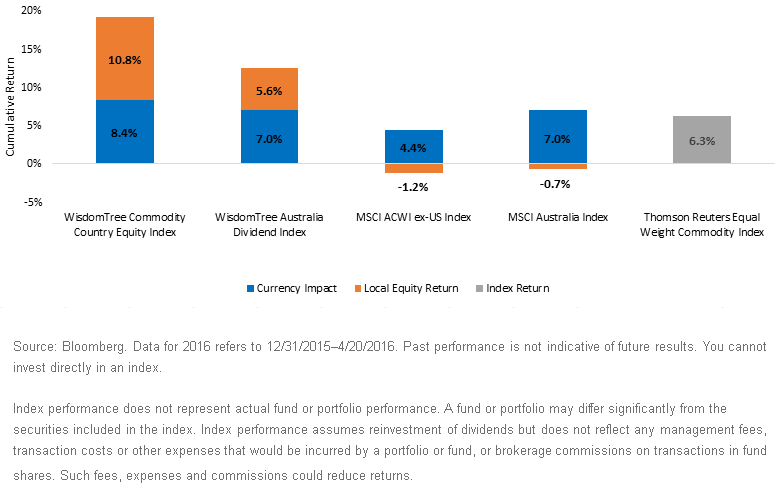What Assets Are Gaining Most with the Bounce in Commodities?



 For definitions of indexes in the chart, visit our glossary.
• Currencies Make a Complete About-Face: In the WisdomTree Commodity Country Equity Index thus far this year, the Russian ruble is up nearly 13% and the Brazilian real is up 12.3%, while the currency return of the Index has been a positive 8.4%. The high beta of this approach has come largely from a currency impact that has been approximately twice as strong as that of the MSCI AC World ex-US Index. It is interesting that with the 6% gain in commodities, the Index is up nearly three times as much off this initial rebound.3
• WisdomTree Australia Dividend Index Crushes MSCI Australia Index: The MSCI Australia Index had more than 50% of its weight in Financials, which was more than twice the exposure of the WisdomTree approach. This means that the WisdomTree strategy is over-weight in most of the other sectors—and since they are nearly all doing better than Australia’s Financials sector, this has helped. Additionally, mid- and small caps in Australia have done well, and the WisdomTree Australia Dividend Index had greater exposures here due to its approach weighted by dividend yield.
1Source: Bloomberg, for period from 12/31/2014 to 12/31/2015.
2Source: “Economic Projections of Federal Reserve Board Members and Federal Reserve Bank Presidents under Their Individual Assessments of Projected Appropriate Monetary Policy, December 2015” Federal Reserve.
3Source: Bloomberg, for period from 12/31/2015 to 4/20/2016.
For definitions of indexes in the chart, visit our glossary.
• Currencies Make a Complete About-Face: In the WisdomTree Commodity Country Equity Index thus far this year, the Russian ruble is up nearly 13% and the Brazilian real is up 12.3%, while the currency return of the Index has been a positive 8.4%. The high beta of this approach has come largely from a currency impact that has been approximately twice as strong as that of the MSCI AC World ex-US Index. It is interesting that with the 6% gain in commodities, the Index is up nearly three times as much off this initial rebound.3
• WisdomTree Australia Dividend Index Crushes MSCI Australia Index: The MSCI Australia Index had more than 50% of its weight in Financials, which was more than twice the exposure of the WisdomTree approach. This means that the WisdomTree strategy is over-weight in most of the other sectors—and since they are nearly all doing better than Australia’s Financials sector, this has helped. Additionally, mid- and small caps in Australia have done well, and the WisdomTree Australia Dividend Index had greater exposures here due to its approach weighted by dividend yield.
1Source: Bloomberg, for period from 12/31/2014 to 12/31/2015.
2Source: “Economic Projections of Federal Reserve Board Members and Federal Reserve Bank Presidents under Their Individual Assessments of Projected Appropriate Monetary Policy, December 2015” Federal Reserve.
3Source: Bloomberg, for period from 12/31/2015 to 4/20/2016.
Important Risks Related to this Article
Foreign investing involves special risks, such as risk of loss from currency fluctuation or political or economic uncertainty.
Investments focused in Australia increase the impact of events and developments associated with the region, which can adversely affect performance.
Investments in currency involve additional special risks, such as credit risk and interest rate fluctuations.
Dividends are not guaranteed, and a company currently paying dividends may cease paying dividends at any time.

Christopher Gannatti began at WisdomTree as a Research Analyst in December 2010, working directly with Jeremy Schwartz, CFA®, Director of Research. In January of 2014, he was promoted to Associate Director of Research where he was responsible to lead different groups of analysts and strategists within the broader Research team at WisdomTree. In February of 2018, Christopher was promoted to Head of Research, Europe, where he was based out of WisdomTree’s London office and was responsible for the full WisdomTree research effort within the European market, as well as supporting the UCITs platform globally. In November 2021, Christopher was promoted to Global Head of Research, now responsible for numerous communications on investment strategy globally, particularly in the thematic equity space. Christopher came to WisdomTree from Lord Abbett, where he worked for four and a half years as a Regional Consultant. He received his MBA in Quantitative Finance, Accounting, and Economics from NYU’s Stern School of Business in 2010, and he received his bachelor’s degree from Colgate University in Economics in 2006. Christopher is a holder of the Chartered Financial Analyst Designation.

